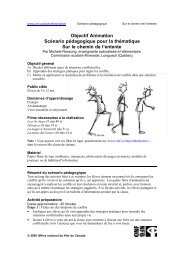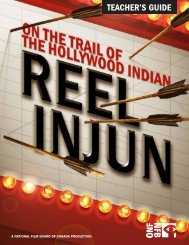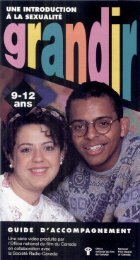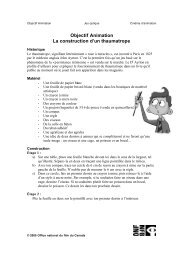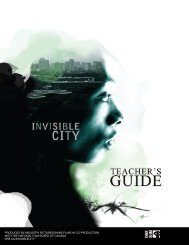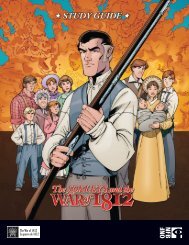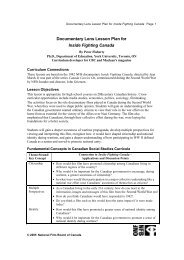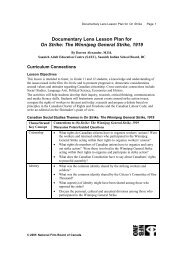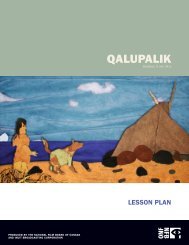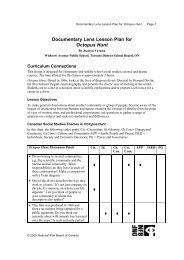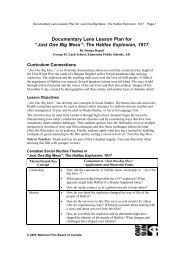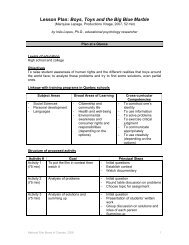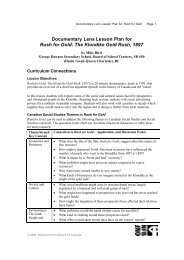THE Reluctant Deckhand - Office national du film du Canada
THE Reluctant Deckhand - Office national du film du Canada
THE Reluctant Deckhand - Office national du film du Canada
Create successful ePaper yourself
Turn your PDF publications into a flip-book with our unique Google optimized e-Paper software.
<strong>THE</strong><strong>Reluctant</strong><strong>Deckhand</strong>\Teacher's Guidefor the Novel & Film
The <strong>Reluctant</strong> <strong>Deckhand</strong> - Novel published by Pacific E<strong>du</strong>cational PressAuthor:Editor:Illustrator:Book Designer:Jan PadgettCarolyn SaleAmanda ForbisWarren ClarkThe <strong>Reluctant</strong> <strong>Deckhand</strong>: Teacher's Guide for the Novel and FilmAuthors: Cheryl Macdonald, Oyster River School,Campbell River School District #72, B.C.Janet Pivnick, Faculty of E<strong>du</strong>cation, University of British ColumbiaThe activities in this guide were created by the following team of e<strong>du</strong>cators &consultants:Cheryl MacdonaldDarlene Forrest, Qualicum School District #69, B.C.Kim Rasmussen, Trail Central School, Trail School District #11, B.C.Jan Wells, Dr. R.E. McKechnie School,Vancouver School District #39, B.C.Jan Padgett, Writer/Director, novel & <strong>film</strong>, Powell River, B.C.Catherine Edwards, Pacific E<strong>du</strong>cational Press,University of British ColumbiaBetty Wilson, Sliammon Native Council,Powell River School District #47, B.C.Guide Coordination:Editing and Proofreading:Graphic Design:Cover Artwork and Blackline Masters:Thanks to:Trevor G rig gSabina HarpeJoAnn HarrisonMary JamesSue MilliganJohn PriceBev StewartAnne TaylorLynne WilliamsStaff of Charles Dickens School, VancouverJan Clemson, NFB Pacific CentreMerrill Fearon Communications Inc.Dennis Smith, Fine Line StudioAmanda ForbisA Guide to Reading and Viewing The <strong>Reluctant</strong> <strong>Deckhand</strong> 4Curriculum Connections 6Themes and ActivitiesRelationships 8Life on the Coast 12Stewardship of the Earth 14Exploring the Storyteller's Art 18Blackline MastersA Storyboard Page 20Create Your Own Storyboard 22Animate Tess 24Map of Georgia Strait 26Navigation Chart 28A Page from the Henry Bay's Log 30Resource Materials 32Film Credits 35Ordering Information 36ISBN 0-7722-0614-7©The National Film Board of <strong>Canada</strong>,P.O. Box 6100, Station Centre-Ville, Montreal, Quebec H3C 3H5Printed in <strong>Canada</strong>, 1995Teachers may photocopy any part or all of this Guide for classroom use.
The <strong>Reluctant</strong> <strong>Deckhand</strong> packageconsists of:• a 33-minute animation <strong>film</strong> in sixépisodes• a 13-minute documentary• a 128-page novel• this Teacher's Guide.The <strong>film</strong>maker, ]an Padgett, alsowrote the novel. Amanda Forbiscreated the <strong>film</strong>'s animation as wellas the book's illustrations. Both the<strong>film</strong> and the novel are recommendedfor children eight to twelve years old.SYNOPSISTess is ten years old - old enough, now, to join hermother, Sue, for a summer on the Henry Bay, Sue'sfishing boat. Sue wants Tess to fish for cod with her inthe northern waters off Vancouver Island, but Tess fearswhat might happen in places like Blackfish Sound,Scarlett Point, and Alert Bay. Tess doesn't want to go,and she doesn't want to spend the summer so far awayfrom her best friend, Candice.But Tess does go, and over the summer the reluctantdeckhand becomes a resourceful fisher and a skillful crewmember. She rises to the challenge of tidal currents andstorms, and thrills in the summer's unexpectedpleasures - sighting dolphins, coming breathtakinglyclose to orcas, exploring the deserted Native village ofMemcwumlees.Tess has a companion on her expedition, Maa-mou thecat, a good-bye present from Candice. Maa-mou'scuriosity gets them both into trouble but the cat'splayfulness helps them solve dilemmas too. A moremature Tess is eventually capable of what she oncewould have thought impossible - taking the wheel of theHenry Bay while her mother helps a boat in distress.0APPROACHES TO READING AND VIEWINGEither the <strong>film</strong> or the novel can be enjoyed independently,and many of the activities suggested in this guidecan be used with either form. However, studying boththe <strong>film</strong> and novel, which were created by the sameperson, affords an opportunity for students to explorethe characteristics of each medium.The story invites students to make their own personaland relevant responses. These may be expressed inmany different forms, for example through talk, art,diagrams, writing, dramatization or music. It is importantto encourage and allow a variety of responses sothat students can demonstrate their thinking in waysthat capitalize upon their strengths and help themdevelop new skills.<strong>THE</strong>MES AND BIG IDEAS IN THIS GUIDEBoth the <strong>film</strong> and novel are full of possibilities. For this Teacher'sGuide, we have developed activities within the themes ofRelationships, Stewardship of the Earth, Life on the Coast andThe Storyteller's Art.Threaded throughout the story are big ideas such as:• meeting challenges, and changing and growing as a result;• the relationship between feelings and actions;• dealing with conflict and solving problems;• the beauty and fragility of the natural environment;• the effects of changing technology and making consciouschoices about how you live and interact with yourcommunity and environment.Throughout this guide, we have developed activities toexplore these themes and ideas. Students and teachers will findmany more avenues for their own explorations.
Both the <strong>film</strong> and novel integrate naturallyinto many curriculum areas:LANGUAGEARTSreadingwritinglisteningspeakingviewingrepresentingcritical thinkingSCIENCE ANDMA<strong>THE</strong>MATICSstudying the environmentstudying the ocean includingresearching life-cycles andhabitats of marine life, andtides and currentsstudying weatherobserving, comparing,classifyinggraphing and chartingnavigating and orienteering«SOCIAL STUDIESmappingexploring regions of <strong>Canada</strong>through literature and <strong>film</strong>studying the art, work and lives ofFirst Nations peoples, using thebasket as a starting point "exploring historical aspects of lifeand work on the West Coast andthe effects of technologyexamining relationships,interactions, and families<strong>THE</strong> ARTSobserving and sketchingwatercolour paintingweavinganimationnoticing and using design,pattern, and linedramatization and role playingcreating songs and sound effectsrepresenting responsesmaking models and threedimensionalrepresentationsEXPLORING CAREERSAND PERSONAL PLANNINGexploring relationships andfeelingsexploring and recognizingpersonal growth and changenoticing and practising conflictresolution and problem-solvinggoal-setting and decision-makingstudying the work and lifestyles ofvarious peopledeveloping an awareness of thechanging roles of women andmen in our society
•Tess and her mother grow in their understanding of each other as a result ofspending the summer together. As well, Tess and Candice maintain a longdistancefriendship by exchanging postcards until they are able to meet in AlertBay with Candice's Auntie Betty, an Elder who begins to share her knowledgeabout the cedar tree and basket weaving with them. These activities examinerelationships and provide opportunities for students to make connections withtheir own experiences.Throughout the reading/viewing, plot out the key events, along with Tess'feelings, on a graph. A similar plot line could be developed for Sue. If theseplot lines are recorded on overhead transparencies using a different colourfor each, they can be superimposed and compared. For example:• Create a sociogram showing the relationships among the characters of thestory. This sociogram could be developed at the beginning of the story,then again at the end. For example:I, frustrated;Using events identified on the plot line, have students choose one in whicha character may be feeling/thinking something different from what they'resaying. Have students illustrate this using talk balloons and thought bubbles.For example:Keep an ongoing record of the challenges Tess faces and their outcomes.Have students connect Tess' challenges with challenges they have faced.Some connections for students might include:• Think of a time when you left your friends to go away with your family.• Think of a time when you had to do something challenging and metwith success.Tejs
• Have the students develop character profiles of Sue and less at the beginningof the story, then again at the end. Include descriptions of behaviour,motivations and feelings, as well as physical appearance. For example:Notice how Sue and less deal with conflict. List thekinds of actions they take to prevent a "blow-up".Some things the students might notice are: moving toanother space, coming back to apologize, puttingfeelings into words, and seeking comfort from pets orthrough writing. Have the students role-play problematicsituations from home or school using some of thesestrategies to resolve the situation.Have students notice the characteristics of less' family - its composition,pets, responsibilities of family members, and so forth. Then have themcompare this family with their own, charting likenesses and differences.This could be developed to compare likenesses and differences amongfamilies in the class.Discuss the money Tess is earning by helping her mother <strong>du</strong>ring thesummer, how her mother wants a say in how the money will be spent, andwhat Tess decides she would like to buy. The students might like to sharehow they earn money, how they spend it, and what their financial goals are.$o farWofn'edIn the novel, Auntie Betty teaches Candice about making baskets andhands down traditions and responsibilities, as does Sue to Tess. Have thestudents create a skit in which an older family member or friend teaches ayoung person. These skits may be based upon the students' personalexperiences of learning from "Elders" in their families.Have students reflect on the friendship of Tess and Candice, and identifythe qualities that make them such good friends. Then have them reflect ontheir own friendships. From these reflections and discussions, try to developa profile of a good friend, and strategies people use to develop and sustainfriendships.There are many other ways in which students mightwish to represent their responses to the characters inthe story. For example, they might write a journal fromTess' point of view, write postcards from Tess andCandice, or act out scenes from this story or fromimagined future adventures of Sue and Tess aboard theHenry Bay. As well, they might like to keep personaljournals, or write postcards to their own friends.
This novel and <strong>film</strong> offer a glimpseof the beauty and interconnectednessof people, animals,land, sea and weather. In thissection, students are givenopportunities to observe their ownenvironment more carefully, toresearch animals and the impacthumans have on their habitats,and to understand how somehuman activities threaten thisfragile web while others protectand enhance it.• Discuss with students aspects of the coastal environment that stood out forthem in the <strong>film</strong> or the novel. Use this list to help them create a class muralcomplete with features of the land and seascape, animals, weather conditions,and impact by humans.• Create a corresponding list and mural illustrating their own community'senvironment.• Have indivi<strong>du</strong>als or small groups of students choose and research ananimal from the novel or <strong>film</strong>, or from their own environment. Encouragethem to learn about its habitat, its diet, conditions for survival, place in thefood chain and how it protects itself. Explore ways in which humans affectits life and what can be done to protect it.The students' findings might bepresented to the class as a report,a captioned painting, a story,an "interview" with theanimal or in otherforms.• In the story, Sue comments upon the presence offish farms and clearcuts.Ask students to choose one or both of these as issues to investigate further.Suggest that they ask questions such as: What are the effects on theenvironment? What concerns do you think Sue has? What other practicesmight be more environmentally sound? What are your opinions?• In response to less' interest in the ocean, Sue comments, "Yes, it's anotherworld under there. And one we'd better take care of. It's all connected —land, ocean, air." Invite the students to discuss what they think Sue meansby this, and begin to talk about ways they can take care of where they live.Have them make a list of actions they could take in their own school orcommunity.• Explore the ways in which teachers, administrators and students are, or arenot, taking care of their school's environment. Have students design a classproject that enhances theenvironment of their classroom,school orneighbourhood.• Re-read or re-view thesection of the story whereCandice, Auntie Betty, lessand Sue visit Memcwumleesto gather cedar for makingbaskets. Notice how thecedar trees are respectedand cared for, and howanything that is taken is usedcompletely. Talk about whythat might have beenimportant. With the supportof other resources, have thestudents illustrate andexplain how the cedar tree(or some other naturalresource) has traditionallybeen used by First Nationspeople.
• Discuss the importance to theHenry Bay of tide, current andweather information. Find out ifthere are people in yourcommunity whose livelihoodsare affected by weather, forexample: farmers, loggers,fishers or utility workers. Whatis the typical weather pattern inyour community? How does itaffect your work and play?• Visit a beach or other naturallocation in your communitybefore and after a storm tonotice the effects of weather onthe land. Then re-view sectionsof the <strong>film</strong> to see the artist'stechnique in depicting differentweather conditions. Havestudents draw or paint calm orstormy seascapes, or have themillustrate their findings bycreating three-dimensionalscenes before and after a storm.• Heighten awareness of thesounds of the weather, thewater and the beach byreviewing the storm section ofthe <strong>film</strong> without sound. Havethe students create their ownsoundscape to perform with this part of the <strong>film</strong>. Then watch this sectionwith the sound turned on and have the students compare their sounds tothose in the <strong>film</strong>. Students may also wish to make a soundscape specific totheir area.Every culture has accumulated observations about weather which are oftenexpressed as "sayings". Examples of this are: "Red sky in the morning,sailors take warning; red sky at night, sailors' delight" and "When the daysbegin to lengthen, the cold begins to strengthen." What examples of suchlore do students know? Suggest that they ask some of the older membersof their families or communities what weather sayings they learned whenthey were young. What modern practices have re<strong>du</strong>ced our reliance onsuch observations?When the Henry Bay visits the lighthouse at Scarlett Point, Tess learns alittle about the modern innovations that have made lighthouses moreefficient and effective. Ask students to think of other modern inventionsthat make our lives easier and safer, for example sonar or radar. Helpstudents create a list of devices that make their community or neighbourhooda safer and easier place to live.
The interpretation of this <strong>film</strong> into a novel, and the additional documentary onthe process of creating these two versions of The <strong>Reluctant</strong> <strong>Deckhand</strong>, providean opportunity to learn more about the art of storytelling.• View the documentary in whichauthor and director Jan Padgettand animator Amanda Forbis talkabout the process of creating this<strong>film</strong> script, animation <strong>film</strong>, andnovel. Invite the students to sharetheir thoughts and reactions, andfrom this discussion, develop aprofile of the qualities they thinkwriters and animators might need.As well, draw and label the timeline for this whole process ofdevelopment.• Show students the samplestoryboard (pages 20-21) for the<strong>film</strong> The <strong>Reluctant</strong> <strong>Deckhand</strong>.Notice how the storyboard capturesthe key elements or mainideas of the story, then have thestudents write captions for eachpicture.• Invite students to create their own storyboard for a story of their own, orperhaps for another episode from the <strong>film</strong>, using the blank storyboardblackline master (pages 22-23). Encourage them to use a combination ofdistant and close-up shots, and to include labels and dialogue.• Explore the idea of animation by having students create a flip book in thecorner of a notebook, drawing one simple image at the top corner (e.g.,seagull, Maa-mou, fish) and changing the drawing very slightly from onepage to the next. Further understanding about animation could be develope<strong>du</strong>sing the NFB <strong>film</strong> Animando or the book Flipbook Animation andOther Ways to Make Cartoons Move.View a section of the <strong>film</strong> to notice how feelings are shown in this animation.Draw the students' attention to how eyebrows, mouths, and handschange to represent different emotions.1 Using the blackline master"Animate less" on pages 24-25,have students cut out the eyebrows,eyes, and mouths andmove them around the face toshow a range of feelings.1 Using the blackline master onpages 24-25 as a reference, havestudents create their owncharacters and animate the faces.• View one section of the <strong>film</strong> again,this time with the sound turnedoff. Discuss the effect of thisexperience. Then re-view with thesound turned on and list all thesound effects. Discuss the effect ofthe sounds and music on the story.In the documentary about themaking of the <strong>film</strong>, view themusicians creating the musicalaccompaniment. Students maywish to create their own retelling of another story using musicalaccompaniment and sound effects.To compare the ways in which a writer and a <strong>film</strong>maker may treat a momentin a story, choose a special event in the plot (for example, when Tesssees the orcas swimming beneath her kayak) or a mood (for example, Tess'frustration with her mother). Notice how the novel uses words to create apicture of the scene for our imaginations. Then notice how the <strong>film</strong> usessound, music, and image to present the story.
23-OOT TO
If&usi 6w*i,
eyes-
Adapted from original map by Warren Clark
D£S(LAT1QN SOUN
g: 3D Browning, Jluly /y9°iy w/+b cJoudy periods
Books for ChildrenAndrews, Jan. Illustrated by Ian Wallace. Very Last First Time. Vancouver, BC:Douglas & Mclntyre, 1985.Bouchard, David. Illustrated by Henry Ripplinger. If You're Not from thePrairies. Vancouver, BC: Raincoast Books and Summerwild Pro<strong>du</strong>ctions, 1993.. Illustrated by Roy Henry Vickers. The Elders Are Watching. Tofino,BC: Eagle Dancer Enterprises, 1990.. White Tails Don't Live in the City. Winnipeg, MB: Whole LanguageConsultants, 1989.Hartman, Gail. Illustrated by Harvey Stevenson. As the Crow Flies: A First Bookof Maps. New York: Aladdin Books, 1991.Lawson, Julie. Illustrated by Sheena Lott, A Morning to Polish and Keep. RedDeer, AB: Red Deer College Press, 1991.Leger-Haskell, Diane. Illustrated by Dar Churcher. Maxine's Tree. Victoria, BC:Orca Book Publishers, 1990.Mason, Adrienne. Illustrated by Elizabeth Gatt. Photographs by DavidDenning. Oceans. Toronto, ON: Kids Can Press, 1995.Mazer, Anne. Illustrated by Steve Johnson. The Salamander Room. New York:Alfred A. Knopf, 1991.McFarlane, Sheryl. Illustrated by Ken Campbell. Tides of Change: Faces of theNorthwest Coast. Victoria, BC: Orca Book Publishers, 1995.. Illustrated by Sheena Lott. Jesse's Island. Victoria, BC: Orca BookPublishers, 1992._. Illustrated by Ron Lightburn. Waiting for the Whales. Victoria, OrcaBook Publishers, 1991.Silverstein, Shel. The Giving Tree. New York: Harper & Row, 1964.Sliammon Native Council. Mink and the West Wind. Powell River, BC:Sliammon Native Council and School District #47, c/o James ThompsonElementary School, 6388 Sutherland Ave., Powell River, BC V8A 4W4.Waterton, Betty. Illustrated by Ann Blades. A Salmon for Simon. Vancouver,BC: Douglas & Mclntyre, 1986.Wheatley, Nadine and Donna Rawlins. My Place. Brooklyn, NY: Kane/MillerBook Publishers, 1991.Related Teacher ReferencesBlackstaff, Shirley. Eagles, Evergreens, and Everyone. Ladysmith, BC: 3MPublications, 10825 Island Highway, R.R. #3, Ladysmith, BC VOR 2EO, 1991.Bruchac, Joseph and Michael j. Ca<strong>du</strong>to. Keepers of the Earth. Saskatoon, SK:Fifth House, 1991.Ford, John K.B., Graeme M. Ellis and Kenneth C. Balcomb. Killer Whales: TheNatural History and Genealogy of Orcinus orca in British Columbia and WashingtonState. Vancouver, BC: UBC Press, 1994.Graham, Donald. Keepers of the Light: A History of British Columbia's Lighthousesand Their Keepers. Madeira Park, BC: Harbour, 1985.. Lights of the Inside Passage: A History of British Columbia's Lighthousesand Their Keepers. Madeira Park, BC: Harbour, 1986.Klocher, Donna and Brenda Boreman. Orca Studies. Cabriola, BC: PacificEdge Publishing, 1995.Juvenile Novels from Pacific E<strong>du</strong>cational PressGaetz, Dayle Campbell. A Sea Lion Called Salena. Vancouver, BC:Pacific E<strong>du</strong>cational Press, 1994.Haig-Brown, Alan. The SuzieA. Vancouver, BC: Pacific E<strong>du</strong>cationalPress, 1991.Home, Constance. The Jo Boy Deserts & Other Stories. Vancouver, BC:Pacific E<strong>du</strong>cational Press, 1992.1994.__. Trapped by Coal. Vancouver, BC: Pacific E<strong>du</strong>cational Press,Walsh, Ann. Moses, Me & Murder. Vancouver, BC: Pacific E<strong>du</strong>cationalPress, 1988.
Related NFB Films & VideosAnimando (0087 021). Dir. Marcos Magalhaes, 1987, 13 min.Beautiful Lennard Island (Children of <strong>Canada</strong> Series) (0177112). Dir. BeverlyShaffer, 1977,24min.Distant Islands (0181 052). Dir. Bettina Maylone, 1981, 6 min.Estuary (0179 174). Dir. Don White, 1979, 12 min.ThelntertidalZone^85 040). Dir. David Denning, 1985, 17 min.Island of Whales (0190 031 ). Dir. Mike Poole, 1990, 55 min.Journey of the Blob (Look Again Series - Vol. II) (0089 067). Dir. Bill Maylone,1989, 10 min.A Kid's View of <strong>Canada</strong> (9192 174). Dir. Nicolette Saina, 1992, 28 min.The Treasure of the Crotoceans (0080 061 ). Dir. Co Hoedeman, 1980, 16 min.The Trout That Stole the Rainbow (0182 095). Dir. Eva Szasz, 1982, 8 min.Where the Bay Becomes the Sea (0184 096). Dir. John Brett, 1984, 30 min.Media E<strong>du</strong>cation ResourcesHearn, Emily. Illustrated by Mark Thurman. Draw & Write Your Own PictureBook. Markham, ON: Pembroke Publishers, 1990. (This book contains stepby-stepinstructions for kids to create their own storyboard for a picture bookwhich would be perfectly usable for a <strong>film</strong> animation too.)Jenkins, Patrick. Flipbook Animation and Other Ways to Make Cartoons Move.Toronto: Kids Can Press, 1991.WRITTEN Sc DIRECTED BYJan PadgettDESIGNED & ANIMATED BYAmanda ForbisORIGINAL MUSICJ. Douglas DoddPICTURE EDITORDebra RurakSOUND DESIGNGael MacleanSPECIAL THANKS TOSusan Milligan St the Henry BayTHANKS TOPaul Spong (Orcalab)Don Graham (Point Atkinson Lighthouse)Barb CranmerPRODUCERGeorge JohnsonEXECUTIVE PRODUCERSBarbara JanesDon HaigSvend-Erik Eriksen<strong>THE</strong> RELUCTANT DECKHANDA National Film Board of <strong>Canada</strong>,Pacific Centre Pro<strong>du</strong>ction©1995 <strong>THE</strong> NATIONAL FILM BOARD OF CANADA
Ordering InformationThe following <strong>Reluctant</strong> <strong>Deckhand</strong> materials are available fromPacific E<strong>du</strong>cational PressFaculty of E<strong>du</strong>cation, University of British ColumbiaVancouver, B.C. V6T 1Z4Tel: (604) 822-5385The <strong>Reluctant</strong> <strong>Deckhand</strong> novelISBN 1-895766-01-XThe <strong>Reluctant</strong> <strong>Deckhand</strong> package (novel, video and teacher's guide)ISBN 1-895766-11-7The <strong>Reluctant</strong> <strong>Deckhand</strong> video and teacher's guideISBN 1-895766-09-05"The <strong>Reluctant</strong> <strong>Deckhand</strong>" Teacher's Guide for the Novel and FilmISBN 1-895766-15-XThe following <strong>Reluctant</strong> <strong>Deckhand</strong> materials are available fromNFB Video Sales1-800-267-7710The <strong>Reluctant</strong> <strong>Deckhand</strong> video and teacher's guideNFB order number: 9195 141The <strong>Reluctant</strong> <strong>Deckhand</strong> package (novel, video and teacher's guide)NFB order number: 9193C 9195 141"The <strong>Reluctant</strong> <strong>Deckhand</strong>" Teacher's Cuide for the Novel and FilmNFB order number: 908C 9195 141Repro<strong>du</strong>ction of information from Canadian Hydrographie Service charts in this publicationare for illustrative purposes only. They do not meet the requirements of theCharts and Publication Regulations of the <strong>Canada</strong> Shipping Act and are not to beused for navigation. The appropriate charts, corrected up-to-date, and the relevantcomplementary publications required under the Charts and Publications Regulationsof the <strong>Canada</strong> Shipping Act must be used for navigation.For Navigational Charts contact:Chart Sales and Distribution <strong>Office</strong>Canadian Hydrographie ServiceDepartment of Fisheries and OceansInstitute of Ocean Sciences, Patricia Bay9860 West Saanich RoadSidney, B.C. V8L 4B2Telephone (604) 363-6358 FAX (604) 363-6390
(packagehis Teacher's Guide is part of acontaining:• a 128-page novel,The <strong>Reluctant</strong> <strong>Deckhand</strong>,written by Jan Padgetta 33-minute animation <strong>film</strong>in six episodes~» a 13-minute documentaryon the making of the <strong>film</strong>• this 36-page Teacher's GuideINFBM7T3I




